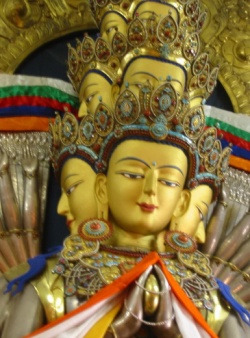Difference between revisions of "Bhavanga"
(Created page with "thumb|250px| Bhavanga (Pali, "ground of becoming") is the most fundamental aspect of mind in Theravada Buddhism. It is an exclusivel...") |
|||
| Line 4: | Line 4: | ||
The [[bhavanga]] {{Wiki|concept}} does not directly address certain questions first raised in the [[Kathavatthu]]. The limits of [[Abhidharmic]] analysis were first raised there, then more specifically by the [[Sautrantikas]], and then finally explicitly and systematically by the [[Yogacharins]]. | The [[bhavanga]] {{Wiki|concept}} does not directly address certain questions first raised in the [[Kathavatthu]]. The limits of [[Abhidharmic]] analysis were first raised there, then more specifically by the [[Sautrantikas]], and then finally explicitly and systematically by the [[Yogacharins]]. | ||
| − | In the [[Theravadin]] [[Abhidhamma]], both conceptualizing and [[mental]] [[consciousness]] normally arise conditioned by other [[mental states]]. However, they also have an unspecified kind of [[rūpa]] ({{Wiki|matter}}, [[form]]) as "support [[condition]]" and "basis." Peter Harvey finds that incorporating this [[physical]] basis more fully may answer certain questions that the [[Abhidhamma]] does not address. | + | In the [[Theravadin]] [[Abhidhamma]], both [[conceptualizing]] and [[mental]] [[consciousness]] normally arise [[conditioned]] by other [[mental states]]. However, they also have an unspecified kind of [[rūpa]] ({{Wiki|matter}}, [[form]]) as "support [[condition]]" and "basis." Peter Harvey finds that incorporating this [[physical]] basis more fully may answer certain questions that the [[Abhidhamma]] does not address. |
| − | In modern times, [[Theravadins]] such as [[Nyanatiloka]] [[Thera]] have departed from [[traditional]] descriptions of the [[bhavanga]], broadening the scope of the {{Wiki|concept}}. [[Nyanatiloka]] [[Thera]] suggests that the [[bhavanga]] can be used to explain continuity of the [[personality]] in a lifetime, but that the {{Wiki|nervous system}} could also be the register in which [[sense]] [[impressions]] are stored. | + | In {{Wiki|modern}} times, [[Theravadins]] such as [[Nyanatiloka]] [[Thera]] have departed from [[traditional]] descriptions of the [[bhavanga]], broadening the scope of the {{Wiki|concept}}. [[Nyanatiloka]] [[Thera]] suggests that the [[bhavanga]] can be used to explain continuity of the [[personality]] in a [[lifetime]], but that the {{Wiki|nervous system}} could also be the register in which [[sense]] [[impressions]] are stored. |
{{W}} | {{W}} | ||
[[Category:Mind]] | [[Category:Mind]] | ||
Latest revision as of 03:22, 29 August 2014
Bhavanga (Pali, "ground of becoming") is the most fundamental aspect of mind in Theravada Buddhism. It is an exclusively Theravada doctrine that differs from Sarvastivadin and Sautrantika theories of mind, and has been compared to the Mahayana concept of store-consciousness. The term does not occur in the Nikayas, though the Theravada tradition identifies it with one that does; the phenomenon described as "luminous mind." The Theravada tradition asserts that it is the bhavanga that motivates one to seek nibbana. It is first found in the Patthana, part of the Theravada Abhidhamma Pitaka.
The bhavanga concept does not directly address certain questions first raised in the Kathavatthu. The limits of Abhidharmic analysis were first raised there, then more specifically by the Sautrantikas, and then finally explicitly and systematically by the Yogacharins.
In the Theravadin Abhidhamma, both conceptualizing and mental consciousness normally arise conditioned by other mental states. However, they also have an unspecified kind of rūpa (matter, form) as "support condition" and "basis." Peter Harvey finds that incorporating this physical basis more fully may answer certain questions that the Abhidhamma does not address.
In modern times, Theravadins such as Nyanatiloka Thera have departed from traditional descriptions of the bhavanga, broadening the scope of the concept. Nyanatiloka Thera suggests that the bhavanga can be used to explain continuity of the personality in a lifetime, but that the nervous system could also be the register in which sense impressions are stored.
